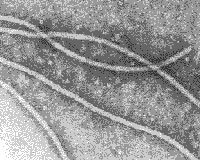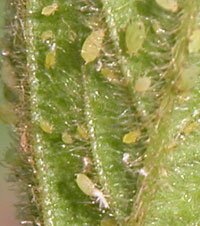
-
Soybean Diseases
- Asian Rust
- Anthracnose
- Bacterial Blight
- Bacterial Pustule
- Bean Pod Mottle Virus
- Brown Stem Rot
- Cercospora Leaf Blight
- Charcoal Rot
- Downy Mildew
- Frogeye Leaf Spot
- Green Stem Syndrome
- Iron Deficiency Chlorosis
- Phytophthora Root & Stem Rot
- Powdery Mildew
- Rhizoctonia
- Seedling Diseases
- Septoria (Brown Spot)
- SCN (Soybean Cyst Nematode)
- Soybean Mosaic Virus
- Stem Canker
- Sudden Death Syndrome
- Viruses
- White Mold
- Soybean Pests
- Diagnostic Help
- Field Trials
- Soybean Library
| Disease: Mosaic Virus |
Your Soybean Checkoff.
Delivering Results.
Illinois
Indiana
Iowa
Kansas
Michigan
Minnesota
Missouri
Nebraska
North Dakota
Ohio
South Dakota
Wisconsin
Soybean Mosaic Virus
 |
| Particles of a potyvirus, similar to SMV. Photo credit: Rothamsted Experiment Station |
|
|
 |
| Soybean aphids can spread Soybean mosaic virus froim plant to plant as they feed. |
Soybean mosaic virus (SMV) infects mostly legumes, with soybean as the primary agronomic host. The main concern about SMV is the effect on seed quality. Virus-infected plants may produce fewer, smaller, and often mottled seed.
The virus consists of rod-shaped particles of RNA and protein that can only grow and reproduce inside a living plant cell. Like all viruses, SMV is not a cellular organism and can not spread by wind, water, soil or plant debris.
SMV transmission
Infected seed is the most important way that soybean mosaic virus is introduced into a soybean field. Seed transmission depends on variety, ranging from 5-75%. In most modern soybean varieties, rates of seed transmission are 0%-5%.
Once the virus is in the field, aphids can spread it from plant to plant as they feed. Over 30 species of aphids transmit SMV worldwide. The soybean aphid, (Aphis glycines) is one of the aphids vectors of SMV.
Synergistic effect of multiple viruses infections
Mixed infections of two or more viruses in a single plant result in more severe symptoms than single infections. High yield losses can occur with combined infection that would not occur with infection by a single virus.
Multiple virus infection also increases the level of seed transmission of SMV, depending how early in the season the plant is infected.
With the recent increase in incidence of bean pod mottle virus (BPMV) in the region, the potential for synergism between SMV and BPMV has increased.
